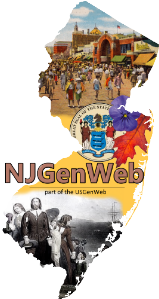Organization of Warren County
The Legislature of New Jersey passed an act November 20, 1824, by which Warren County was erected from Sussex with boundaries as follows:
"All the lower part of the county of Sussex beginning' on the river Delaware at the mouth of Flatbrook, in the township of Walpack, and running from thence a straight course to the northeast corner of Hardwick church, situated on the south side of the main road leading from Johnsonburg to Newton, and from thence in the same course to the middle of Musconetcong creek, be, and the same is hereby erected into a separate county, to he called "the County of Warren"'; and a line running from thence down the middle of the said Musconetcong creek to where it empties into the Delaware, shall hereafter be the division line between the counties of Morris and Hunterdon and the said county of Warren."
Warren County is bounded on the west and northwest by the Delaware
River and on the southeast by the Musconetcong. The upper part of the
county "is about sixteen miles in width and holds that measurement with
a slight increase, for nearly half the length of the county, when it is
suddenly reduced to about half that width by the bend of the Delaware
coming in from Pahaquarry to Manunka Chunk, where it runs almost at
right angles with its former course. If the river continued on in this
direction, it would strike across the country from Manunka Chunk to
Changewater in the line of the Delaware, Lackawanna & Western Railroad;
but the river makes a bend westward again and then eastward, forming the
point above Belvidere, whence it proceeds in a southwesterly course past
the western point of Harmony township, and then runs in a southerly
zig-zag course to the great bend at Holland, in Hunterdon county. The
Musconetcong valley on the opposite side of the county is much more
uniform, that stream flowing in a curve which varies not more than two
miles from a direct line, from one extremity of the county to the other.
The extreme length of the county from the Sussex line near Waterloo to
Musconetcong Station is about thirty miles, and as near as can be
measured on the map its superficial area is three hundred and seventy
square miles."
The principal ranges of mountains in Warren County are the Kittatinny,
or Blue Mountains in the northwestern part, the Jenny Jump in the
central part, Scott's Mountains between Harmony and Oxford townships and
the Pohatcong mountains in the southwest. The principal streams are the
Paulinskill and its tributaries, Beaver Brook, Pequest, Pohatcong and
Musconetcong.
Warren county was originally part of West Jersey. It was included in
Hunterdon when that county was erected in 1713-14 and remained a part of
it till Morris was set off in 1738-39. It was a part of the territory of
Sussex county when that county was erected in 1753 and so remained till
the Legislative enactment of November 20, 1824, made a separate county
of it.
The first settlements were made along the Delaware river at what is now
Phillipsburg and Pahaquarry before the territory of West Jersey was
organized into the county of Hunterdon. The townships of Warren County
at time of its organization were Greenwich, Hardwick, Pahaquarry,
Mansfield, Oxford, Knowlton and Independence.
The first board of chosen freeholders met at Belvidere May 11th, 1825,
and these townships were represented in it. Belvidere was selected by a
vote of the citizens of the county -- taken April 19 and 20 1825 -- as
the County-seat. The grounds on which the public buildings are located
were donated to the county by Gen. Garrett D. Wall of Trenton by will
dated June 7, 1825. The buildings were erected on the grounds thus
donated in 1826 at a cost of about ten thousand dollars.
The Poor-house and farm were purchased by the county of Nathan Sutton in
1829 for the sum of $8950. It then contained about 390 acres. William
McDaniel was the first steward and Dr. J. T. Sharp the first physician.
Source: Weaver & Kern, compilers, Warren County History and Directory or The Farmers' Manual And Business Mens' Guide (Washington, NJ: Press of the Review, 1886), 104-106.
Adjacent Counties
- Sussex County, north
- Morris County, east
- Hunterdon County, south




